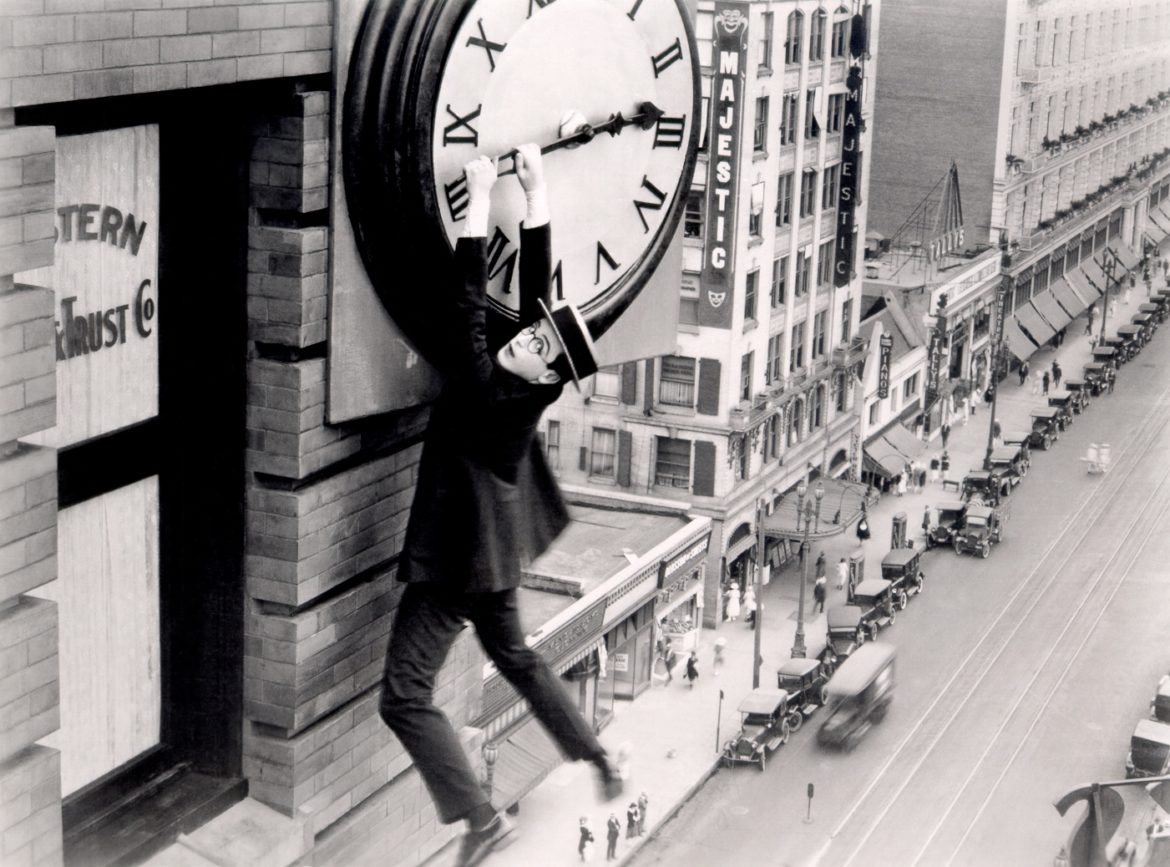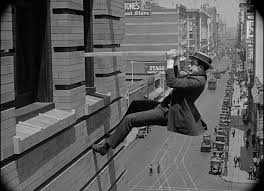Part of an ongoing effort to watch each of the films in Roger Ebert’s Great Movies series. The introduction and full list can be found here.
Why did the image of Harold Lloyd‘s “Glasses character” – pasty, spectacled, straw boater still perched precariously on his head – dangling from the minute hand of a clock 12 stories up become one of cinema’s most enduring images?
Many people know the shot even if they don’t know the film, or anything about the Silent Era for that matter, and it’s lingered in the cultural imagination in ways only truly iconic images can. (Sure, Back To The Future probably helped its legacy, too, but bear with me.)
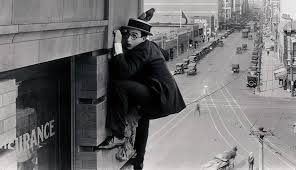 At least one reason lies in its improbability – that this nerdy, kind of boring-looking fellow should be in such peril. Even as a still, there’s an incongruous humor to his situation – a situation which is frankly terrifying, if you have any fear of heights, I might add – since it seems someone who looks like Lloyd shouldn’t be up there at all. What is he even doing?
At least one reason lies in its improbability – that this nerdy, kind of boring-looking fellow should be in such peril. Even as a still, there’s an incongruous humor to his situation – a situation which is frankly terrifying, if you have any fear of heights, I might add – since it seems someone who looks like Lloyd shouldn’t be up there at all. What is he even doing?
This is central to Lloyd’s charm. Unlike Chaplin‘s Tramp, an exaggerated and often (delightfully) sentimental figure, or Buster Keaton‘s stone-faced character, whose gag-filled misfortunes and their consequences seem almost cosmic in scope, Lloyd is … just some guy. In Safety Last!, he’s a kid from the small town working in a big city department store, where he routinely messes things up. All he wants is to do a good job, a position that pays enough to bring his sweetheart to live with him, but … these things just keep happening to him.
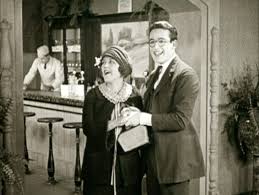 The irony from our perspective is that Lloyd’s athleticism is what enables him to pull off the general gag of being a putz. Like Chaplin and Keaton, he created a proper character – the hapless but well-meaning Everyman who defies the odds and ends up with the girl. He’s so normal you temporarily forget he’s not Lloyd himself, the kind of hapless Everyman who can also apparently climb walls and fall off trains, and once blew up his thumb and forefinger in the line of comedic duty. It’s no surprise at all that martial artists like Jackie Chan admire him, along with the other two. In Safety Last!, Lloyd’s athleticism is on full display.
The irony from our perspective is that Lloyd’s athleticism is what enables him to pull off the general gag of being a putz. Like Chaplin and Keaton, he created a proper character – the hapless but well-meaning Everyman who defies the odds and ends up with the girl. He’s so normal you temporarily forget he’s not Lloyd himself, the kind of hapless Everyman who can also apparently climb walls and fall off trains, and once blew up his thumb and forefinger in the line of comedic duty. It’s no surprise at all that martial artists like Jackie Chan admire him, along with the other two. In Safety Last!, Lloyd’s athleticism is on full display.
This is a good thing, because, after a half dozen viewings, I’m convinced the film could be a paradigm of Roger Ebert’s notion of the Idiot Plot: “Any plot containing problems that would be solved instantly if all of the characters were not idiots.”
See, in Safety Last!, Lloyd promised his sweetheart that he had already succeeded in the city. So, when she comes to visit, he has to pretend he’s a big-shot. This leads, as you expect, to some problems, since no one particularly respects him at all.
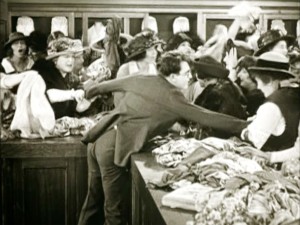 In some alternate universe, he could take The Girl aside and say, “I’m sorry, The Girl. I am not the General Manager of this department store. I felt pressure to succeed and to fulfill your hopes for us, but I was ashamed, and so I may have exaggerated things. The important thing is our love for each other.”
In some alternate universe, he could take The Girl aside and say, “I’m sorry, The Girl. I am not the General Manager of this department store. I felt pressure to succeed and to fulfill your hopes for us, but I was ashamed, and so I may have exaggerated things. The important thing is our love for each other.”
Of course, there would then be no movie at all, so he does not say this. Cue the gags, and the eventual circumstance that Lloyd himself has to climb a 12-story building, rather than the far more qualified pal he set up the gig for in the first place.
The hammy plot is forgivable for two reasons. First, those gags turn out to be inspired and amazing. And not just the climactic final scene. The first 10-15 minutes of Safety Last! are jam-packed with wonderful routines.
The film opens on a visual joke that should be at least as famous as Lloyd battling the pigeons on the side of the department store, in which everything we see indicates a hanging is about to take place, until the perspective shifts and we’re actually seeing our protagonist off at the train station. From there, he grabs the luggage and boards the wrong train; we meet him in the city, where he and his broke pal hide from the landlady by leaping into coats hung on the wall; he’s early to work but gets whisked off by a laundry truck and struggles to find a ride back to town, in hilarious fashion; sneaks back into work pretending to be a mannequin; and on and on.
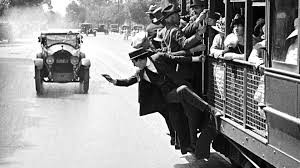 The famous final 15 minutes of Safety Last! deserve all their praise, but I laugh harder every time at its first 15, and frankly enjoy them more, as my palms don’t sweat. There’s a manic, wonderful sense that the filmmakers and gag-writers wanted to cram every joke they could think of into the frame, and they do.
The famous final 15 minutes of Safety Last! deserve all their praise, but I laugh harder every time at its first 15, and frankly enjoy them more, as my palms don’t sweat. There’s a manic, wonderful sense that the filmmakers and gag-writers wanted to cram every joke they could think of into the frame, and they do.
Second, director/legend Hal Roach, Lloyd, and their fellow filmmakers actually do craft a pretty well-rounded narrative out of the goofy central idea (something that distinguishes Lloyd’s films from Keaton’s in many cases, which always seemed a bit shaky on the narrative front). Idiot Plot issues aside, the story proceeds along in its 7 reels pretty efficiently, especially for a film that strings together so many elaborate gags. Special mention should also go to the intertitles, which not only advance the story but are often full-fledged jokes themselves. (A favorite: “There were certain days she could expect a letter from him. Those days were Monday, Tuesday, Wednesday, Thursday, Friday, Saturday, and Sunday.”)
Of course, the climb up the department store facade is what most viewers remember. And why not? It’s incredible. We now know Lloyd didn’t do it quite as it’s presented, but he did plenty. And in any case, those are definitely people scurrying up several stories like Human Flies, or balancing precariously on edges. The real magic is in the camera perspective, in its effect on us, not just the willingness of actors to break their necks (though they did that frequently enough). For good reason, current health and safety codes forbid this sort of thing, but the combination of adventure movie thrills and comic shenanigans in Safety Last! still informed so many movies over the years.
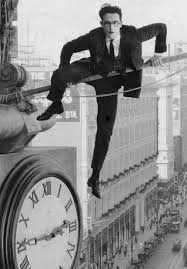 Deeper meanings? Some have pointed out that climbing the building is a literalization of the struggle to achieve and succeed under capitalism, as Lloyd ascends to respectability and marriage. This seems a totally reasonable reading, certainly in the context of period. But as far as authorial intent goes, I tend to think Harold Lloyd saw a guy climbing up a building one day and thought it would look awesome on film.
Deeper meanings? Some have pointed out that climbing the building is a literalization of the struggle to achieve and succeed under capitalism, as Lloyd ascends to respectability and marriage. This seems a totally reasonable reading, certainly in the context of period. But as far as authorial intent goes, I tend to think Harold Lloyd saw a guy climbing up a building one day and thought it would look awesome on film.
He was right.
Favorite Ebert quote: “I didn’t find myself laughing, but I watched in fascination. I don’t love the Glasses character with the intensity I reserve for Buster and the Little Tramp. But I was there with him every inch of the way up that building, and I shared the physical joy of his triumph at the top. I could understand why Lloyd outgrossed Chaplin and Keaton in the 1920s: Not because he was funnier or more poignant, but because he was merely mortal and their characters were from another plane of existence. Lloyd is a real man climbing a building; Keaton, as he stands just exactly where a building will not crush him, is an instrument of cosmic fate. And Chaplin is a visitor to our universe from the one that exists in his mind.“
Next up: Souls for Sale – Robert Hughes, 1923

